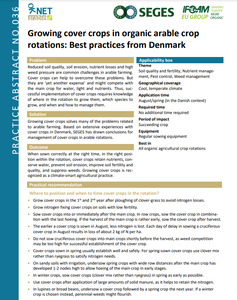{Tool} Growing cover crops in organic arable crop rotations: Best practices from Denmark (OK-Net Arable Practice abstract). Creator(s): Askegaard, Margrethe. Issuing Organisation(s): SEGES. OK-Net Arable Practice abstract, no. 036. (2017)
|
PDF
- English
(Growing cover crops in organic arable crop rotations: Best practices from Denmark)
288kB | |
![[thumbnail of 2023-04-27 16_32_25-Organic-Farm-Knowledge-Tool-description-form.docx - Word.png]](/31051/3.hassmallThumbnailVersion/2023-04-27%2016_32_25-Organic-Farm-Knowledge-Tool-description-form.docx%20-%20Word.png)  Preview |
Image (PNG)
- Cover Image
- English
132kB |
Document available online at: https://orgprints.org/31051/
Summary in the original language of the document
When sown correctly at the right time, in the right position within the rotation, cover crops retain nutrients, conserve water, prevent soil erosion, improve soil fertility and quality, and suppress weeds. Growing cover crops is recognized as a climate-smart agricultural practice.
Practical recommendation
Where to position and when to time cover crops in the rotation?
• Grow cover crops in the 1st and 2nd year after ploughing of clover-grass to avoid nitrogen losses.
• Grow nitrogen fixing cover crops on soils with low fertility.
• Sow cover crops into or immediately after the main crop. In row crops, sow the cover crop in combination with the last hoeing. If the harvest of the main crop is rather early, sow the cover crop after harvest.
• The earlier a cover crop is sown in August, less nitrogen is lost. Each day of delay in sowing a cruciferous cover crop in August results in loss of about 2 kg of N per ha.
• Do not sow cruciferous cover crops into main crops shortly before the harvest, as weed competition may be too high for successful establishment of the cover crop.
• Cover crops sown in spring usually establish well and safely. For spring-sown cover crops use clover mix rather than ryegrass to satisfy nitrogen needs.
• On sandy soils with irrigation, undersow spring crops with wide row distances after the main crop has developed 1-2 nodes high to allow hoeing of the main crop in early stages.
• In winter crops, sow cover crops (clover mix rather than ryegrass) in spring as early as possible.
• Use cover crops after application of large amounts of solid manure, as it helps to retain the nitrogen.
• In lupines or broad beans, undersow a cover crop followed by a spring crop the next year. If a winter crop is chosen instead, perennial weeds might flourish.
Cover crops and weed control
• Problems with creeping thistle, sow-thistle and coltsfoot do not rule out cover crops: Sow the cover crop immediately after an early harvest and ploughing. Repeat ploughing in spring before sowing a spring crop.
• To reduce couch-grass, mechanical treatment in autumn is more efficient than growing a cover crop.
| EPrint Type: | Practice tool |
|---|---|
| What problem does the tool address?: | Reduced soil quality, soil erosion, nutrient losses and high weed pressure are common challenges in arable farming. Cover crops can help to overcome these problems. But they are ‘yet another expense’ and might compete with the main crop for water, light and nutrients. Thus, successful implementation of cover crops requires knowledge of where in the rotation to grow them, which species to grow, and when and how to manage them. |
| What solution does the tool offer?: | Growing cover crops solves many of the problems related to arable farming. Based on extensive experiences with cover crops in Denmark, SEGES has drawn conclusions for management of cover crops in arable rotations. |
| Country: | Denmark |
| Type of Practice Tool: | Practice abstracts |
| Theme: | Nutrient management |
| Keywords: | arable farming, cover crop, crop rotation, nitrogen, nutrient loss, soil quality, weed management |
| Keywords: | arable farming, cover plants, crop rotation, nitrogen, nutrient loss, soil quality, weed management, weed control, nutrient management, soil quality |
| Agrovoc keywords: | Language Value URI English arable farming http://aims.fao.org/aos/agrovoc/c_36528 English cover plants http://aims.fao.org/aos/agrovoc/c_1936 English crop rotation http://aims.fao.org/aos/agrovoc/c_6662 English nitrogen http://aims.fao.org/aos/agrovoc/c_5192 English nutrient deficiencies http://aims.fao.org/aos/agrovoc/c_34868 English soil quality http://aims.fao.org/aos/agrovoc/c_a9645d28 English weed control http://aims.fao.org/aos/agrovoc/c_8345 English nutrient management http://aims.fao.org/aos/agrovoc/c_330697 |
| Subjects: | Soil > Soil quality Crop husbandry > Crop combinations and interactions Crop husbandry > Production systems > Cereals, pulses and oilseeds Crop husbandry > Weed management Farming Systems > Farm nutrient management |
| Research affiliation: | European Union > Horizon 2020 > OK-Net Arable > OK-Net-Arable Tools Denmark > SEGES European Union > Organic Farm Knowledge |
| Horizon Europe or H2020 Grant Agreement Number: | 652654 |
| Related Links: | https://organic-farmknowledge.org/tool/31051 |
| Project ID: | ofk |
| Deposited By: | Forschungsinstitut für biologischen Landbau, FiBL |
| ID Code: | 31051 |
| Deposited On: | 18 Jan 2017 15:24 |
| Last Modified: | 02 May 2024 10:31 |
| Document Language: | English, Danish/Dansk |
| Status: | Published |
Repository Staff Only: item control page

 Download Statistics
Download Statistics Download Statistics
Download Statistics
